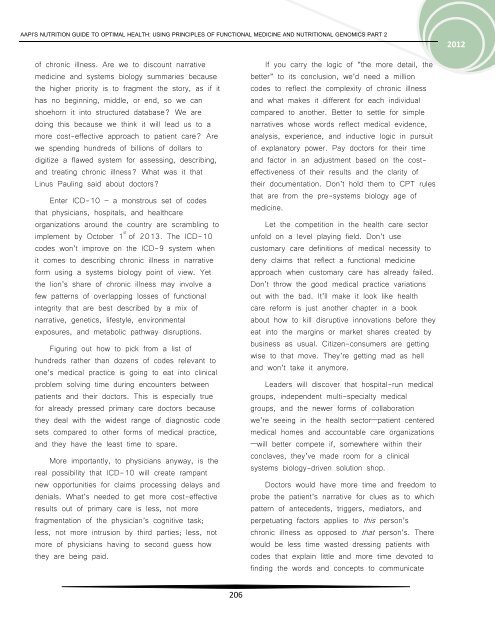optimal health: functional medicine and nutritional genomics
optimal health: functional medicine and nutritional genomics
optimal health: functional medicine and nutritional genomics
Create successful ePaper yourself
Turn your PDF publications into a flip-book with our unique Google optimized e-Paper software.
AAPI’S NUTRITION GUIDE TO OPTIMAL HEALTH: USING PRINCIPLES OF FUNCTIONAL MEDICINE AND NUTRITIONAL GENOMICS PART 2<br />
2012<br />
of chronic illness. Are we to discount narrative<br />
<strong>medicine</strong> <strong>and</strong> systems biology summaries because<br />
the higher priority is to fragment the story, as if it<br />
has no beginning, middle, or end, so we can<br />
shoehorn it into structured database? We are<br />
doing this because we think it will lead us to a<br />
more cost-effective approach to patient care? Are<br />
we spending hundreds of billions of dollars to<br />
digitize a flawed system for assessing, describing,<br />
<strong>and</strong> treating chronic illness? What was it that<br />
Linus Pauling said about doctors?<br />
Enter ICD-10 – a monstrous set of codes<br />
that physicians, hospitals, <strong>and</strong> <strong>health</strong>care<br />
organizations around the country are scrambling to<br />
implement by October 1 st of 2013. The ICD-10<br />
codes won’t improve on the ICD-9 system when<br />
it comes to describing chronic illness in narrative<br />
form using a systems biology point of view. Yet<br />
the lion’s share of chronic illness may involve a<br />
few patterns of overlapping losses of <strong>functional</strong><br />
integrity that are best described by a mix of<br />
narrative, genetics, lifestyle, environmental<br />
exposures, <strong>and</strong> metabolic pathway disruptions.<br />
Figuring out how to pick from a list of<br />
hundreds rather than dozens of codes relevant to<br />
one’s medical practice is going to eat into clinical<br />
problem solving time during encounters between<br />
patients <strong>and</strong> their doctors. This is especially true<br />
for already pressed primary care doctors because<br />
they deal with the widest range of diagnostic code<br />
sets compared to other forms of medical practice,<br />
<strong>and</strong> they have the least time to spare.<br />
More importantly, to physicians anyway, is the<br />
real possibility that ICD-10 will create rampant<br />
new opportunities for claims processing delays <strong>and</strong><br />
denials. What’s needed to get more cost-effective<br />
results out of primary care is less, not more<br />
fragmentation of the physician’s cognitive task;<br />
less, not more intrusion by third parties; less, not<br />
more of physicians having to second guess how<br />
they are being paid.<br />
If you carry the logic of “the more detail, the<br />
better” to its conclusion, we’d need a million<br />
codes to reflect the complexity of chronic illness<br />
<strong>and</strong> what makes it different for each individual<br />
compared to another. Better to settle for simple<br />
narratives whose words reflect medical evidence,<br />
analysis, experience, <strong>and</strong> inductive logic in pursuit<br />
of explanatory power. Pay doctors for their time<br />
<strong>and</strong> factor in an adjustment based on the costeffectiveness<br />
of their results <strong>and</strong> the clarity of<br />
their documentation. Don’t hold them to CPT rules<br />
that are from the pre-systems biology age of<br />
<strong>medicine</strong>.<br />
Let the competition in the <strong>health</strong> care sector<br />
unfold on a level playing field. Don’t use<br />
customary care definitions of medical necessity to<br />
deny claims that reflect a <strong>functional</strong> <strong>medicine</strong><br />
approach when customary care has already failed.<br />
Don’t throw the good medical practice variations<br />
out with the bad. It’ll make it look like <strong>health</strong><br />
care reform is just another chapter in a book<br />
about how to kill disruptive innovations before they<br />
eat into the margins or market shares created by<br />
business as usual. Citizen-consumers are getting<br />
wise to that move. They’re getting mad as hell<br />
<strong>and</strong> won’t take it anymore.<br />
Leaders will discover that hospital-run medical<br />
groups, independent multi-specialty medical<br />
groups, <strong>and</strong> the newer forms of collaboration<br />
we’re seeing in the <strong>health</strong> sector—patient centered<br />
medical homes <strong>and</strong> accountable care organizations<br />
—will better compete if, somewhere within their<br />
conclaves, they’ve made room for a clinical<br />
systems biology-driven solution shop.<br />
Doctors would have more time <strong>and</strong> freedom to<br />
probe the patient’s narrative for clues as to which<br />
pattern of antecedents, triggers, mediators, <strong>and</strong><br />
perpetuating factors applies to this person’s<br />
chronic illness as opposed to that person’s. There<br />
would be less time wasted dressing patients with<br />
codes that explain little <strong>and</strong> more time devoted to<br />
finding the words <strong>and</strong> concepts to communicate<br />
206
















